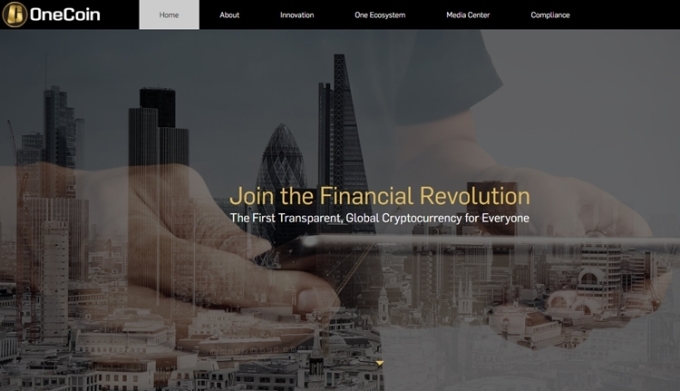How “virtual currency queen” Ruja Ignatova scammed billions of dollars?
She told the cheering crowd that OneCoin was on its way to becoming the largest virtual currency in the world, making it possible for anyone to pay anywhere.
At that time, the virtual currency Bitcoin was creating a fever. Bitcoin was the first virtual currency to appear and is still the most known. Its rise in value from a few cents to hundreds of dollars a coin in mid-2016 has many investors looking to participate in this novel opportunity.

Ruja Ignatova in 2016. Photo: Rex.
Bulgarian Ruja, 36, told an audience at Wembley that OneCoin is “what destroys Bitcoin”. “In the next two years, nobody will talk about Bitcoin anymore!” said the self-proclaimed “virtual currency queen.” She founded two front companies in Dubai and the Central American country of Belize to promote the currency.
Many people all over the world have invested in OneCoin, hoping to be part of the new revolution. British investors spent nearly 30 million EUR ($33 million) on OneCoin in the first 6 months of 2016. From August 2014 to March 2017, more than 4 billion EUR ($4.4 billion) was invested. into OneCoin from people in dozens of countries such as Pakistan, Brazil, Norway, Canada or Yemen.
Money has value only when many people think it has value. Whether it is banknotes, coins, seashells, gems or matches, things that have been used as money, it has value only when people believe it. Many people have long tried to create a form of electronic money, independent of state-issued currencies, but have always failed because no one believes them. There will always be a leader who can manipulate the supply and it’s too easy to fake.
Bitcoin is hot because it solves this problem. This currency depends on a special type of database called a blockchain, which is like a ledger that every Bitcoin owner has an independent but identical copy of. Every time Bitcoin is sent to someone else, a record of that transaction is recorded on everyone’s ledger.
No bank, no government, not even the inventor of Bitcoin, can change or manipulate it. This means that Bitcoin cannot be counterfeited, hacked or fraudulently used using two different transactions to spend the same account balance.
Blockchain databases in particular are key to making cryptocurrencies like Bitcoin work. For many, this is a revolutionary new form of money. As for Ruja, it was an opportunity for her to make money by selling this idea to many people.
In early October 2016, four months after Ruja gave a speech in London, blockchain expert Bjorn Bjercke was invited by a recruitment officer to be the technical director of a virtual currency startup from Bulgaria. Bjercke will get an apartment and a car and an annual salary of around £250,000 ($320,000).
Bjercke asked the recruiter what his job was. “Well, they need blockchain. They don’t have blockchain right now. I said ‘What? You told me it’s a virtual currency company,'” Bjercke said.
The opponent admitted that the virtual currency company had been operating for a while but did not have a blockchain. “What’s the name of the company?” Bjercke asked. After receiving the answer of OneCoin, Bjercke did not take the job.

OneCoin website. Screenshots.
A few months later, 48-year-old British Jen McAdam received a text from a friend about an investment opportunity not to be missed. Sitting at her computer, she clicked a link and joined the OneCoin webinar.
For more than an hour, she listened to enthusiastic presenters about this exciting new virtual currency. “You guys are so lucky to be watching this webinar. You join in the early stages, later it grows like Bitcoin and bigger,” said one presenter.
They mentioned Ruja’s desirable background: a graduate of Oxford University, has a doctorate from Konstanz University, is an expert at the famous management consulting firm McKinsey & Company. They showed Ruja’s speech at a conference organized by the Economist magazine, and that attracted McAdam. “The strength of a woman. I feel proud of her,” McAdam said.
McAdam then invested £10,000 and persuaded family and friends to invest £250,000. She excitedly watched the coin value on OneCoin’s website steadily increase, surpassing the £100,000 mark. She started planning to go shopping and travel.
But at the end of the year, Jen McAdam was contacted by a stranger online who claimed to have researched OneCoin thoroughly and wanted to talk to investors. She reluctantly agreed to chat on Skype and they argued fiercely. However, that dialogue takes McAdam’s life in a new direction.
The stranger is Timothy Curry, a Bitcoin enthusiast and cryptocurrency advocate. He thought OneCoin would give the cryptocurrency a bad name and told McAdam it was a scam. Over the next few weeks, Curry sent her a flurry of information about how cryptocurrencies work through web links, articles, and YouTube videos. She understood that OneCoin does not use the same blockchain technology as Bitcoin. The numbers that keep increasing on OneCoin’s website are practically meaningless. They are just numbers entered by OneCoin staff.
According to OneCoin, the company’s main business is selling educational materials for trading. Members can purchase education packages from 100 EUR to 118,000 EUR or 225,500 EUR. Each package will include tokens to “mine” OneCoin.
Investors need to use real money to register to participate, with the current exchange of 0.1 EUR per token. The more people involved, the more difficult the mining becomes and the more code is spent. To mine OneCoin, you must have many tokens, but to have many tokens, you must “pay to learn”. As more and more people join OneCoin, the amount of money spent will be more.
Central banks and financial management institutions in some countries such as Italy, Norway, and Hungary accuse OneCoin of being not a virtual currency but a form of fraud using the Ponzi scheme: taking money from latecomers and paying for it. who came first. Those who come last often don’t get the money, and when the system can’t expand further, the founders run away or get arrested.
Although McAdam has come to his senses, other OneCoin investors have yet to realize the problem. Ruja travels the world promoting her vision, from Macau to Dubai to Singapore, attracting new investors. OneCoin was still growing fast and Ruja started spending the huge amount of money she earned: buying multi-million dollar real estate in the Bulgarian capital Sofia and the Black Sea resort of Sozopol or having a party on a luxury yacht . In July 2017, Ruja also invited American pop star Bebe Rexha to perform at a private event.
The only way to exchange OneCoin to any other currency is the OneCoin Exchange, the internal market for members. However, it closed unannounced in January 2017, worrying investors. OneCoin Europe executives promised this would be resolved at a meeting in Lisbon, Portugal October 2017. But on the important day, Ruja, who is known for being punctual, doesn’t show up.
“Nobody knows why she wasn’t there,” said one delegate. Everyone was frantically texting and calling but no response. Some fear Ruja is killed or kidnapped by banks because they think most banks are afraid of the virtual currency revolution. In fact, Ruja disappeared at the time US authorities asked for a warrant to arrest her. The number of victims being scammed by Ruja at that time reached more than one million people.
FBI records show that on October 25, 2017, just two weeks after not showing up in Lisbon, Ruju boarded a Ryanair flight from Sofia to Athens and then disappeared. Ruja is said to have had plastic surgery and remains in Europe, most likely living under a fake name in Frankfurt.
Ruja’s younger brother, Konstantin Ignatov, runs OneCoin after Ruja’s disappearance. The US Justice Department said it had evidence of a link between him and “those with a hand in organized crime in Eastern Europe”.

Konstantin Ignatov, brother of Ruja Ignatova. Photo: OneCoin.
On March 6, Konstantin Ignatov was arrested by the FBI at Los Angeles International Airport on charges of fraud related to OneCoin. Around the same time, US authorities charged Ruja with electronic communications fraud, securities fraud and money laundering.
But what is surprising is that OneCoin continues to operate and many people continue to pour money into it. OneCoin has always denied allegations of wrongdoing, saying that it has “all the criteria for the definition of a cryptocurrency”.
Investors said they came to OneCoin out of fear of missing out on a big money-making opportunity. They get jealous when they read stories about people getting rich on Bitcoin and think OneCoin is a second chance.
Many people are impressed by Ruja’s personality and persuasiveness. They felt she had credibility for speaking in front of large audiences. They were shown photos of Ruja’s degree and a copy of the Forbes magazine she featured on the cover.
The degree is real, but the cover of Forbes isn’t: it’s just an advertisement inside the magazine, just pay to appear.
But it’s not just the promise of money that makes people believe. When Jen McAdam invested in OneCoin, she repeatedly said that she was part of the “family”. She was placed in a chat group, where the leader disseminated information from headquarters in Sofia.
McAdam’s team leader warned her against talking to OneCoin skeptics. “You are told not to believe anything from the ‘outside world.’ Don’t listen to Google,” she said. “They call it the OneCoin ‘haters’.”
Professor Eileen Barker of the London School of Economics said there are similarities between OneCoin and cults, where people believe they are part of something big that will change the world. Once joined, it was nearly impossible for them to admit they were wrong, no matter how much evidence there was.
On November 5, Ruja’s brother, Konstantin Ignatov, appeared in court in New York, to testify for the case of a lawyer who allegedly laundered $400 million in OneCoin money earned in the US. A month earlier, Ignatov had accepted a plea deal, admitting to several counts of fraud and money laundering. Ignatov seems to imply that his sister tricked him in the same way as other investors. Ruja disappears for fear that someone close to her will report her to the FBI.
“This scam represents the dark side of rapid technological change, how new technology creates great opportunities and possibilities for those who understand it, but also an opportunity to take advantage of those who don’t.” understand the matter thoroughly,” wrote Jamie Bartlett, a British journalist who investigated Ruja’s whereabouts.
Bartlett believes that Ruja has identified some of the weaknesses of society and exploited them. She knows that there will be people who are hungry for money or easily tempted to bet on OneCoin. She understands that it is becoming increasingly difficult to distinguish truth from falsehood when there is so much conflicting information online. Ruja also understands that when building a group of people who believe in OneCoin, it will be difficult for law enforcement and media officials to uncover the truth.
“And the most frustrating thing is that Ruja correctly guessed that by the time people realized the problem, she was running away with high money,” Bartlett wrote.
at Blogtuan.info – Source: danviet.vn – Read the original article here



